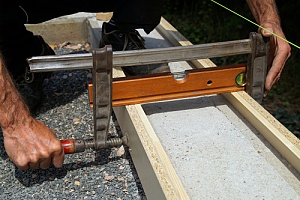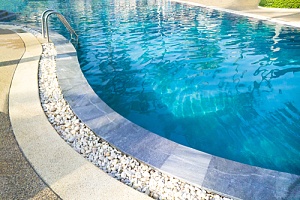A backyard pool can open limitless warm weather possibilities. You can throw fun parties, have a great space for your kids to play all summer, and give yourself a little mini-vacation right in your own backyard.
 Of course, preparing your backyard to have a pool installed can feel like a huge undertaking; with all the planning, preparing, excavating and digging. If only there was a better (easier) way.
Of course, preparing your backyard to have a pool installed can feel like a huge undertaking; with all the planning, preparing, excavating and digging. If only there was a better (easier) way.
We are excited to be the first to tell you there is. That’s right. No digging. Just layering. It’s called land grading. And boy will it save you time and money. In this post, learn more about these unique solutions and find out how to level your backyard for a pool installation this summer.
What is Land Grading?
Land grading is just another way of saying ‘leveling the land.’ The purpose of land grading is simply to take out any elevation variations and to ensure the ground is smooth and level. While you want to make sure your ground is level before installing a pool, land grading can be critical for many construction projects. For example, it does the important job of making sure water can drain properly.
If the land has not been leveled the way it should, water will not be able to drain correctly and could flow in the wrong direction. It could also accumulate in areas where you do not want it. Water can be a real nuisance to try and get rid of and it can cause significant damage that costs a lot of money to repair. By making sure the ground is level at the start of your project, you can save yourself a lot of headaches, and a whole lot of money as well.
Land Grading 101: How to Level Ground Without Digging
Before you begin land grading, it is important to understand every step of the process to ensure it goes smooth. If you do not perform each step accurately, it may cause the need for more work later on. Dirt Connections recommends hiring a professional Northern VA land grading contractor to assist with grading land in your backyard. If you choose to do DIY land grading, here are the steps to leveling ground for a pool without digging:
1. Create A Base
The first and most important step to this process is to create a base that is level for whatever project you have in mind (in this case, a swimming pool). This is a really crucial step in installing a swimming pool since you need the pool to be fully grounded. Putting a pool on top of unlevel land will do nothing but create problems for you down the road. It can cause cracks and issues with the lining, along with other issues.
2. Clear Out Plants
The next step (after creating a base) to land grading is making sure that the area you hope to level is totally clear of any plants. If you have pretty plants you want to keep, you simply need to pot them elsewhere, either temporarily or permanently. Be sure to keep them in the same soil and once your project is over, you can replant them. For a temporary move, using potted plants can be a quick solution if the plant will fit.
3. Inspect The Area
 Next, a good inspection of the area can be performed. This inspection should look for any particularly uneven spots. It can be performed using special equipment, or just visually. It is best to use equipment that will spot areas you would not be able to see with the naked eye. The spots that are lower should be filled in to meet the higher areas.
Next, a good inspection of the area can be performed. This inspection should look for any particularly uneven spots. It can be performed using special equipment, or just visually. It is best to use equipment that will spot areas you would not be able to see with the naked eye. The spots that are lower should be filled in to meet the higher areas.
4. Test The Area With A Plank
Once that is done, a plank can be used to test the evenness of the area. The plank can be moved over the entire space to ensure uniformity. If high spots are found, they can be marked with stakes to be returned to later. Those areas will need to be leveled out further, usually by moving the dirt aside to make the area lower. Since you want to avoid digging, you can simply build up the lower areas instead of digging away the higher ones. If you choose this method to avoid digging, you will want to make sure the dirt you add is fully compacted so that the ground is truly level and will not be subject to shifting.
5. Continue To Check For Levelness
It is imperative to continue to check for levelness throughout the process. This can be done using the same plank and just ensures that the ground is staying level as the project continues. This will prevent you from having to continue to return to places you thought were already level and can be a time saver.
6. Remove Any Existing Debris
Once level, the ground can be raked to remove any debris. That debris might be branches or rocks that you do not want underneath the pool. Then, the soil is tamed. This is a crucial step when putting in a pool since you need the ground to be very firm to withstand the pressure.
7. Water And Tamper The Ground
Once the ground is raked, it should be watered and then rolled to ensure maximum compactness. For ultimate compactness in the soil, a hose or sprinkler can be running on low for around an hour before the ground is tamped. Tamping cannot be overstated in importance, especially with a project such as a pool. You want the ground as firm, taut, and level as possible. Tamping can help make sure the ground is in proper condition to withstand the weight and pressure of your new pool.
Speak With A Northern VA Land Grading Contractor
 While leveling smaller slopes is entirely possible to do on your own, bigger jobs require the assistance of a professional. For example, you could probably level a slope that was 5 to 10 degrees all on your own. It would not necessarily be easy, but it would possible. Any slope bigger than that would require you to reach out to a professional for assistance.
While leveling smaller slopes is entirely possible to do on your own, bigger jobs require the assistance of a professional. For example, you could probably level a slope that was 5 to 10 degrees all on your own. It would not necessarily be easy, but it would possible. Any slope bigger than that would require you to reach out to a professional for assistance.
We encourage you to contact a Northern VA land grading contractor for your needs leading up to your pool installation, especially if you are still questioning how to level ground for a pool without digging. Dirt Connections is one land grading contractor that can fulfill those needs. Contact them for more information or to schedule a backyard land grading consultation. Then, you can be well on your way to enjoying your backyard pool as soon as possible.








































